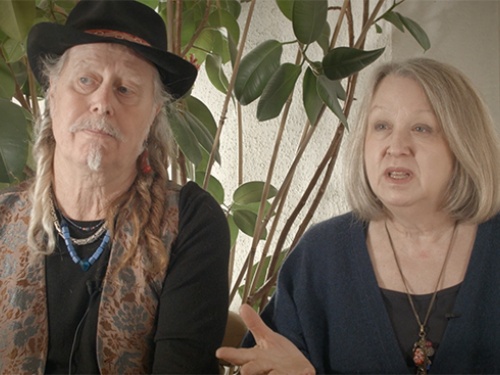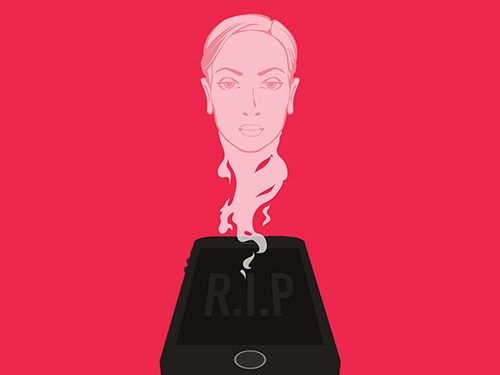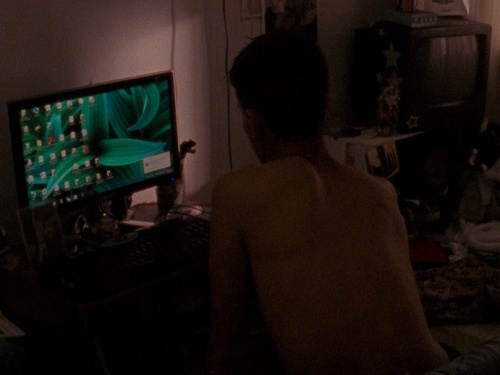no.w.here’s 10th birthday: An Interview with Karen Mirza, Brad Butler and James Holcombe
no.w.here is an artist-run film lab based in Bethnal Green. On Sunday 16 November, to mark their tenth anniversary, they are screening a selection of short films made by artists who have at some point have worked in and with the lab. As an exclusive for the ICA Blog, Seth Pimlott spoke to Karen Mirza and Brad Butler, filmmakers and co-founders of no.w.here, and James Holcombe, also a filmmaker and the head of the lab and education there.
Seth Pimlott: What were your backgrounds before you set up no.w.here, and what was the impetus behind the establishment of it?
Karen Mirza: My background was in painting. I studied at Camberwell College of Arts in the early 90s (92-95), where I then went on to the RCA from 95-97 and met Brad Butler. I had a crisis with my paintings at the end of my second year and changed medium. I took my ideas through what was then called time-based media, which includes film, video, projection, and installation.
Brad Butler: Mine was in anthropology and social geography, which led me easily to documentaries and the joy of making films. My energy combined with my desire for social justice led me to the film school at the RCA. That was also my first meeting with art (at age 23) and “experimental film”, which initially made me angry.
SP: You've been based in Bethnal Green for a few years now. But what were the early days like?
KM: The early days of no.w.here started in my studio at Kingsgate Studios in Kilburn, north west London. We then incorporated into a legal structure in 2004 and rented a larger space from Camden Council—a split-level garage off Kilburn High Road—before we then moved to Bethnal Green in 2007, where we remain. All of the spaces have been full of the most amazing characters, friendships and stories; some people have passed through and stayed for hours, weeks, months and even years.
BB: I remember the early years as being very, very impoverished: in the beginning it really was a labour of love, naivety, creativity and a lot of scarcity. We still had not found our voices as artists, and were feeling out ground blindly as we went with no.w.here whilst we worked multiple other jobs... though we also had the amazing empowerment of experiencing a small gap between thought and action. Between saying “shall we do this event?” and then it actually happening
SP: One of the stated aims of earlier film co-ops was about democratising access to film technology. Does the purpose of a film organisation like no.w.here change now that a new kind of film technology is at everyone’s fingertips?
KM: The technology has certainly changed but the position of artists owning the means of production still remains important to me: artist-run culture asks different questions of the technology, and produces new aesthetic and political languages that are in a constant dialogue with the newer technologies and its social relations. To quote from Deep State, “Chronology is injustice”.
BB: Yes, internally from the beginning Karen and I always spoke of no.w.here as a site of resistance. We were never materialists, but we valued holding a space open for artists as both a resource and a place to gather outside of institutions to think about production across media. If someone one day maps all the people and groups who have passed through the building, it would reflect far more than film alone.
SP: In the 70s and 80s there was a flourishing of radical print and film co-ops and publishers like the See Red Feminist Print Workshop, or the London Film Co-op. It was a struggle for them, but they got by because there was the dole, space was readily available and rent cheap, and if it was needed there was funding from something like the GLC (that thorn in Thatcher's side). What are the logistical differences, and major challenges, in sustaining an organisation like no.w.here now and the 70s/80s?
KM: The main difference is there is no public sector, no left-leaning public body with money for arts projects: instead there is a collection of neo-liberal hubs and pop-up institutions funded by banks. This question is huge! What I can say to this in the present moment is no.w.here is changing in order to reflect the way that artists in this city want to vision change in the arts - "we live in a Utopia - it's just not ours" is going to be our lens through which to interrogate the status quo and attempt to model the change we want to see. This is the frame in which we will re-model our future to ask (amongst many other structural questions): can an artist project become a social project? Modeling and visioning the real question of: how do we as artists exist between the state and the free market?
BB: Riding through austerity measures, the attacks on education and arts funding has also been a huge education for me. The landscape has shifted so much in ten years.
SP: How did you get into filmmaking, and why did 16mm film become important for you?
KM: A crisis with my paintings and the history of painting led me to explore my ideas at the time through another medium, the use of the image as projected, spatialised and temporal was exciting and has still to this day captivated my imagination and political subjectivity. 16mm and Super 8 was the material of choice in the early days, when I was faced with the Hi8 video formats - pre-HD digital cameras and all the familiar visual media we have today. It was the affect of the hallucinatory materialism on the optical unconscious I was drawn to, it felt closer to drawing and painting, which was where I was departing from.
BB: I like working across media now, but 16mm is ingrained in me because the demands of the technology, its instruments and its philosophy are at the centre of time-based thinking, spreading out to photography, theatre, video and the politics of representation.
SP: On Sunday your film Hold your Ground will be screened. For someone who hasn't seen it could you briefly describe what it's about?
KM: Hold Your Ground is inspired by the events of the Arab Spring and the global Occupy movement, and triggered by the artistsʼ discovery in Cairo of a pamphlet of instructions for pro-democracy demonstrators called ʻHow to Protest Intelligently’: the piece dissects the ʻsemanticsʼ of the crowd, and the resulting performative ʻspeech actʼ. Originally conceived for the site at Canary Wharf, this work calls forth the struggle to turn ʻfugitive soundsʼ into speech, addressing an audience predominantly in transit.
BB: The main protagonist is one we are very interested in, and have made new work with. But I will always love this work as it tackles an attempt to teach, whilst struggling to speak.
SP: It was interesting for me to see Hold Your Ground screened beside a more recent film—that uses the same actor in a different setting—at the MIRRORCITY exhibition at the Hayward. Both seem to speak of the body as an instrument of protest, but otherwise they're quite different. Could you describe what happened in the two years between making them that accounts for these differences? And what are the major connections between them?
KM: The actual time of two years is insignificant to the difference in the work - what is of interest to the work is that the chronology of time has been reversed. Everything for Everyone and Nothing for Us is a prequel to Hold Your Ground. It tells the story (allbeit non-verbally) of the coming into being of this language of resistance that the performer in Hold Your Ground directly addresses to us, the citizen, artist, audience. In the prequel this dialogue is with the self, in reflection and rehearsal. We are still constructing a speculative universe in which a protester-in-training retrains her body to resist capitalism; she is real, fictional, fugitive, empowering us to find in our bodies where internalized oppressive power relations reside.
SP: Hold Your Ground is a companion piece to Deep State, a longer, experimental-narrative film you made a few years ago with China Mieville. You've talked about it as the second part of a trilogy of films. Are you currently working on the others, and what will they look at?
KM: We still intend to make two other films in the trilogy of Deep State - this is something that we are going to steal time in our busy lives to focus on next year, we have lots of ideas coming out of the first film that we want to develop but it is way too early to be able to commit them to a public form of print.. watch this space!
BB: It’s true, and thankfully the deep state is itself so imaginative, we are never lacking for material!
Seth Pimlott: Could you describe the space, facilities and atmosphere in no.w.here’s lab?
James Holcombe: The space glints gold at dawn, and glows blue at dusk. The rooms are filled with machines of indeterminate age, which exude promise and potentials undreamt of. These facilities/resources/machines, call them what you will, were created in a Fordist era of cinematic industrial film production and are now re-thinking themselves, finding new ways to give, and receive, and become a part of an artists' work. The atmosphere is by turns intense, musical, joyful, playful, generous, loud, quiet, reflective, monastic, bombastic.
SP: At what point did you get involved with no.w.here and what was your background before filmmaking?
JH: I got involved with no.w.here after running film workshops with musicians and improvisers at the Klinker Club, a live improv/concrete poetry/avant jazz joint in Dalston. Hugh Metcalfe (the curator, musician and Super 8 filmmaker) and I used to run weekend workshops for musicians to film, which we'd hand-process and then play back with a mass improvisation. At this point I was improvising and playing a little myself both solo and in groups, usually working with Super 8 soundtracking silent films.
Food would be made and shared, usually unusual soup combinations. Apple and cheese.
I got very interested in film being a collective and shared experience for people to come together and make work, for image and sound to collide, to experiment, to dream, to create new possibilities.
At this point the old Lux building which housed the LFMC [London Filmmakers Coop] and LVA [London Video Arts] had shut down, there was no centre for artists film production but I kept hearing various rumours that something was going to be set up - eventually I met Karen and Brad, Karen came to one of the workshops, the one where the participants were pelted with stones in a cemetery...
They had just opened a tentative space called no.w.here, using a darkroom for the optical printer and Karen's studio for workshops. We came together and started running Super 8 workshops. Then after a year of this they raised some money via the Esmee Fairburn Foundation to employ another person to work full time at no.w.here, and I went for it. Prior to that I had been working for a children's charity in Hackney, but had always been making Super 8 films I suppose since the late 1990's, failing, learning, failing, learning.
SP: Earlier in the year I remember you quoting someone who had visited no.w.here, who had said something to the effect that working with film in its senescence was exciting because there was ‘nothing to lose’. Can you expand on what you think was meant by this?
JH: That was Vicky Smith in her workshop and screening she co-curated with Karel Doing called Living Film, and not to misrepresent her she said film was 'on the run'.
To misquote Jeff Keen, for me it's a case of 'Film Flies Free'. The industrial cinema is nearly dead, killed off by a few wealthy art collectors in Hollow Wood and now the preserve of a few white male directors who will order millions of feet from Kodak and let a few crumbs fall to us from the table. That's not how I see the future.
The way I see it is that film as medium has nothing to lose and we as artists and filmmakers can go along for the heady ride and see where it leads. On the way we can learn new survival techniques, find new friends and collaborators, build new factories, make the digital 3D printer print us the machines we need. We can become self-sufficient, we can step outside of history, commerce, capital, the binary... whilst still choosing to step back into it if we so wish.
SP: On Sunday you are showing Iron Toned Lady. This was shot at Margaret Thatcher’s funeral, with a cohort of other filmmakers connected to no.w.here. It sounds like a Mass Observation exercise, a quasi-anthropological survey of an especially weird moment - what were your findings?
JH: Well there were a few of us that went, only three people filmed... and only two of us made a formal finished film out of the footage!
So speaking for myself: it was a chance to exorcise the voice, the presence, that had been in my head since birth, to come to an understanding and realisation that what was being laid to rest was a figurehead, an icon, an embodiment of something which has no one face or name, but as many as those by which Satan may be called... to see the forces of wealth, capital, state and monarchy and how they would behave, what rituals of power would be enacted, the echoes that might return.
The wriggling underbelly exposes itself briefly to light.
Also to see who would come out to protest, who would come to mourn. I ended up in a press of Falklands War veterans who kept shouting at people to 'lower their fucking iPads’ but seemed to respect and acknowledge the 16mm camera as something they could identify with, something they knew.
The one thing I took from it which I will always remember was seeing the back doors of St. Paul's open and those politicians and 'celebrities' deemed low risk, or low grade, flooding out into the crowds and blinking in astonishment at being pitched into us plebby masses, amongst them Heseltine, Wogan, Bercow, and Coe. ■
The Tin Screen: no.w.here's 10th birthday is taking place in the ICA's Cinema 1 on Sunday 16 November; everything starts at 13:15.
This article is posted in: Events, Film, Interviews
Tagged with: Karen Mirza, Brad Butler, James Holcombe, theory, Film, interview, Student Forum





